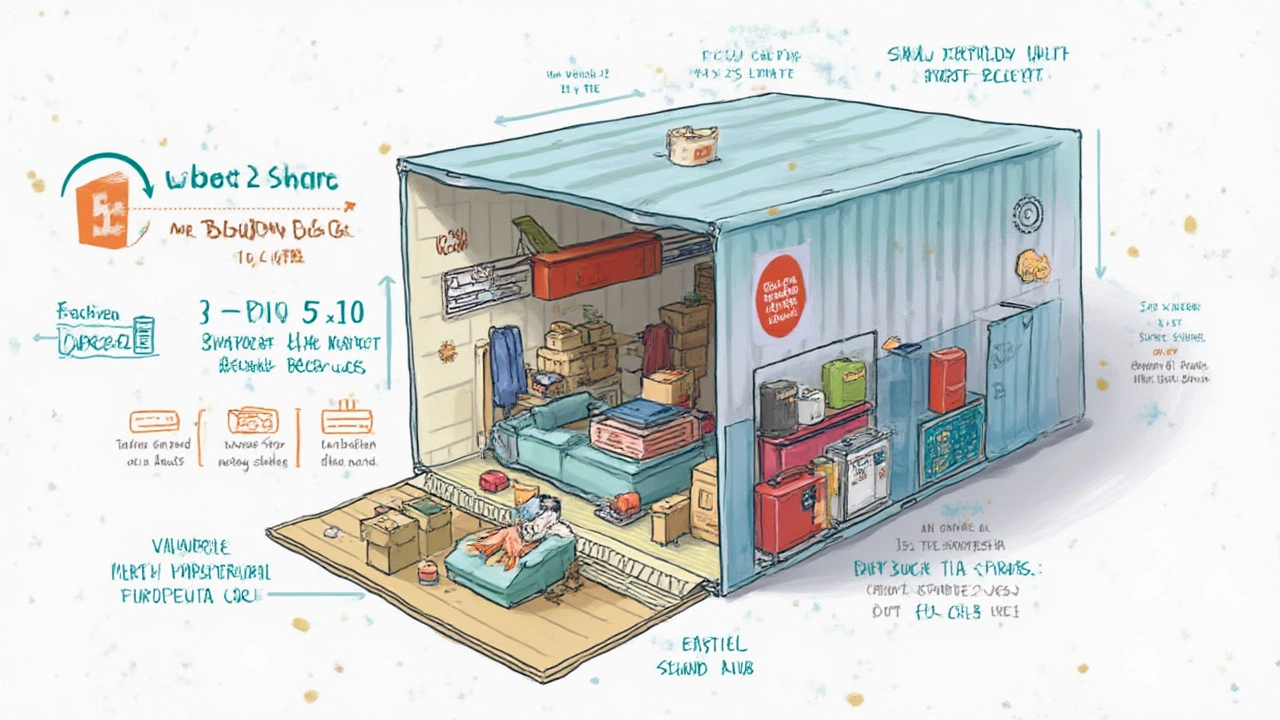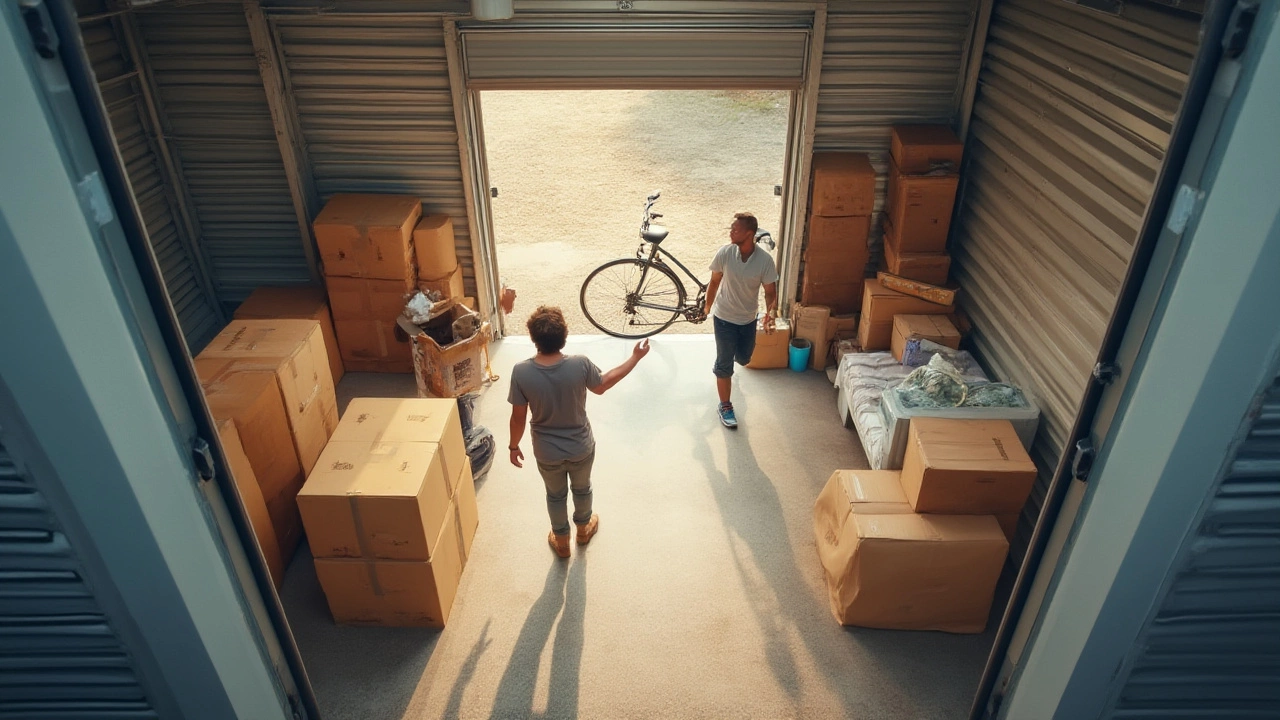Did you know the average American home has more than 300,000 items? No wonder so many people are turning to storage units for help. The tricky part is picturing what actually fits inside a 5x10 storage room before you commit. You hear "5x10" and it sounds small, right? But how small—and what can you realistically pack in there without having things tumble out every time you open the door? Let’s get real about the true size, what it holds, and how to master every square inch for your stuff, whether you’re storing after a move, decluttering, or making room during a home remodel.
Just How Big Is a 5x10 Storage Room?
First, let’s talk dimensions. A 5x10 storage room measures five feet wide by ten feet deep, with a ceiling usually eight feet high—sometimes more in newer facilities. Picture half of a typical garage or roughly the size of a large walk-in closet. Here’s a breakdown in plain numbers:
| Feature | Size |
|---|---|
| Width | 5 feet (1.52 m) |
| Depth | 10 feet (3.04 m) |
| Height | 8 feet (2.44 m) standard |
| Total Floor Space | 50 sq. ft. (4.65 sq. meters) |
| Total Volume | 400 cu. ft. (11.33 m³) |
That 50 square feet might not sound like much, but with eight feet of height, you get a surprising amount of usable space—especially if you think vertical. If you’ve ever played Tetris, this is your time to shine. Here’s a fun comparison: a 5x10 storage unit has about the same footprint as two office desks pushed together. For people who like more visual references, you could park a full-size couch inside—sideways, but comfortably. For most users, this size is considered “small,” falling right between the little 5x5 lockers and bigger 10x10 rooms.
Storage units aren’t just empty boxes, either. Some have roll-up doors like garages. Most have concrete floors, overhead lighting, and sometimes climate control—pretty important if you’re storing wooden furniture, electronics, or anything that doesn’t like humidity swings. A survey by the Self Storage Association in 2024 reported nearly 60% of renters opt for climate control, especially in hot or wet states.
How do facilities measure? Most places go by interior wall-to-wall, but always double-check. Around six-in-ten customers report finding the actual dimensions to be a few inches shorter due to insulation or framing. If you have something that’s 10 feet long—like a kayak—be sure to bring a tape measure before moving day.
What Fits in a 5x10 Storage Room: Real-Life Examples
A 5x10 storage room can hold more than you might expect—if you’re smart about it. But there’s no magic. The golden rule: plan before you start piling things in. Here are specific, concrete examples of what fits so you aren’t left guessing:
- 1-2 rooms’ worth of furniture: Think a queen mattress set, nightstands, a dresser, some chairs, end tables, and a couple of boxes. Yes, really. If you stack things well, you’ll be surprised what can slide in.
- Bicycles, a golf bag, sports gear.
- Holiday decorations and family keepsakes.
- A small washer and dryer—side by side, not on top of each other (unless yours can be stacked).
- About 10-20 large moving boxes. People underestimate this: Stackable boxes are game-changers. If you use identical box sizes, you’ll maximize your usable square footage.
- Musical instruments: A drum set, keyboard, and a few guitars (in cases).
- A love seat, lamp, and compact bookshelves.
What might not fit? Giant sectional sofas, extra-large appliances, and tall wardrobe cabinets that don’t break down. If you’re storing office goods, think a few file cabinets, boxes full of paperwork, maybe a compact copier. Looking at average rental data, small business owners often use 5x10 units like mini stockrooms for overflow supplies—around 18% of renters, to be exact.
Packing for storage requires honesty: Are you keeping three coffee tables because you might need them "someday"? Donate one. (Hey, less is always more.) Another real-life hack: Disassemble furniture when possible—it can save you up to 25% more space, especially with beds or tables that have detachable legs. Don’t forget vertical room for things like standing lamps and tall mirrors—just wrap them carefully so nothing topples and cracks.
Stacking is the name of the game, but be mindful: Don’t make hazardous towers. Stick heavier items at the bottom and lighter ones on top. And always leave a path to the back. Some renters actually sketch a quick layout on paper before loading up to avoid headaches later. Those who pack haphazardly end up spending hours rummaging for holiday lights or Grandma’s china.

Making the Most of Every Inch: Pro Tips for Your 5x10 Storage Room
Let’s talk strategy: Making a 5x10 storage room work is all about maximizing both floor space and height. Here’s how people squeeze the most out of their units:
- Install shelves: Freestanding shelf units (metal or sturdy plastic) transform your vertical space. You can double your storage without your boxes collapsing under weight.
- Label everything clearly. Side of the box works best if you’re stacking. Sounds simple but saves hours of hunting later.
- Use vacuum-seal bags for clothes, towels, and bedding. They shrink to half (or less!) the size of normal folding. There’s a reason why moving pros love them.
- Bag up small pieces—screws, hardware, cords—in zip-close bags. Tape them to the frame of the thing they belong to, so you’re not searching for that one bracket later.
- If you’re stacking furniture on top of each other, put moving blankets or cardboard between layers to avoid scratches and damage.
- Place items you might need sooner near the entrance. That way, you’re not pulling everything out just to grab your winter boots or your kid’s baby photo albums.
- Don’t overpack! 80% of people who regret their storage rental did so because they underestimated how hard it is to get to things in a too-stuffed unit.
- Keep a simple inventory list (paper on the door or a note on your phone). You’ll never wonder “Did I store my slow cooker or did my sister borrow it?” again.
- Consider shelving or even stacking bins to help keep things sorted. Clear bins are perfect if you want to see what’s inside at a glance.
People sometimes overlook the importance of air flow in storage. Don’t pack everything wall-to-wall (especially if you’re storing upholstered furniture or electronics). Leave a little gap for air behind big pieces. Mold and mustiness don’t need much encouragement in humid climates. If you’re in a hot area, using moisture absorbers—like those silica gel packs or store-bought crystals—can keep things dry.
Climate control isn’t just a luxury. If you’re packing away old photographs, vinyl records, or electronics, paying for that feature is often worth it. Data from Public Storage’s 2024 customer survey showed belongings kept in climate-controlled units reported 67% fewer mold and damage claims over 12 months than traditional units.
Security counts, too. Always ask about cameras, access codes, and on-site staff. It’s peace of mind for your valuables, not just an upsell. The best-run facilities will show off their security features without you having to ask.
Visualizing Your 5x10 Storage Room: What to Expect Before You Rent
People are often shocked at move-in—either by how much or how little fits. So let’s paint a real picture. Walk inside a 5x10 room and your first impression is cozy, not claustrophobic. You’ll be able to stand in front, take two full steps in, and still reach the far wall—no acrobatics required.
Here’s what you might see in an optimized unit:
- Stacked on the back wall: Mattress frame (upright), mattress (vertical), two bedside tables below.
- Middle: Boxes lined against side walls, tall bookshelves standing upright acting like extra dividers.
- Front: Folded futon, a bicycle, and small appliances tucked into gaps.
Your walking path will be smaller as you fill up, but you won’t feel trapped if you use vertical storage and proper stacking. If you’re a visual thinker, imagine this: one wall for boxes, one for furniture, with a clear aisle down the middle for access.
Light matters, too—a windowless room can feel darker than expected. Bring a headlamp, or choose a facility with decent ceiling-mounted lighting. Some folks prefer to lay a cheap plastic mat at the entry to keep things clean. (Concrete floors can get dusty, especially in older buildings.)
If you’re storing fragile items like glassware or collectibles, use specialty boxes with dividers and keep these on top of stacks or on shelves to avoid crushing. Never lay your TV flat to save space—keep it upright and wrapped in thick blankets. Speaking of TVs, most flat-screens up to 55 inches will sit nicely along the five-foot wall if you pack carefully.
How about moving day? Bring helpers if you have bulky items. Even though the space itself isn’t massive, awkward shapes and tight corners can make a solo move a challenge. Pop off doors or shelves on big furniture before hauling them across town—this saves both space and nerves.
Don’t forget the power of community reviews. Before you rent, check photos posted by former users. These images are way more helpful than sales brochures, which sometimes use wide-angle lenses that stretch the appearance of the space.
So, next time you’re staring at your pile of "must-keeps" and wondering if a 5x10 storage room is enough, remember: clever packing wins every time. You can store more than you think without living in a maze of boxes. Bring a tape measure, sort what matters most, and keep adaptability in mind. You might end up loving the order it brings—not just to your storage, but to your life outside the unit.


